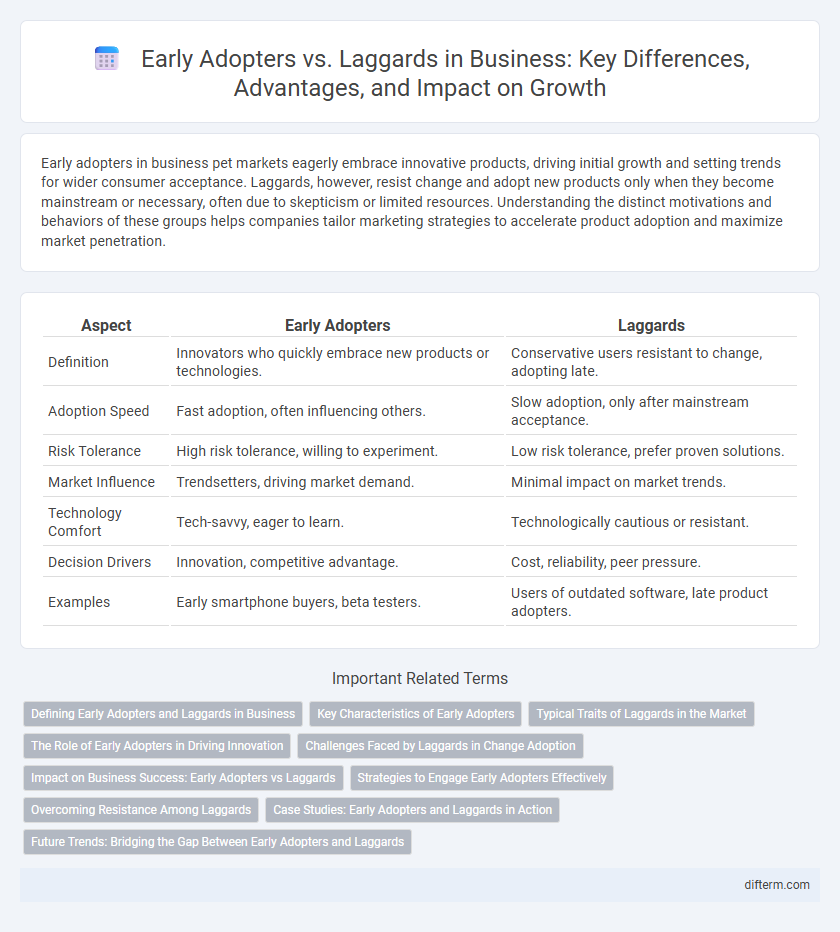Early adopters in business pet markets eagerly embrace innovative products, driving initial growth and setting trends for wider consumer acceptance. Laggards, however, resist change and adopt new products only when they become mainstream or necessary, often due to skepticism or limited resources. Understanding the distinct motivations and behaviors of these groups helps companies tailor marketing strategies to accelerate product adoption and maximize market penetration.
Table of Comparison
| Aspect | Early Adopters | Laggards |
|---|---|---|
| Definition | Innovators who quickly embrace new products or technologies. | Conservative users resistant to change, adopting late. |
| Adoption Speed | Fast adoption, often influencing others. | Slow adoption, only after mainstream acceptance. |
| Risk Tolerance | High risk tolerance, willing to experiment. | Low risk tolerance, prefer proven solutions. |
| Market Influence | Trendsetters, driving market demand. | Minimal impact on market trends. |
| Technology Comfort | Tech-savvy, eager to learn. | Technologically cautious or resistant. |
| Decision Drivers | Innovation, competitive advantage. | Cost, reliability, peer pressure. |
| Examples | Early smartphone buyers, beta testers. | Users of outdated software, late product adopters. |
Defining Early Adopters and Laggards in Business
Early adopters in business are customers or organizations that quickly embrace new products, technologies, or innovations, often driving initial market momentum and providing valuable feedback. Laggards represent the opposite segment, typically resistant to change, adopting innovations only after they become mainstream or necessary due to external pressures. Understanding these distinct groups helps businesses tailor marketing strategies, product development, and adoption lifecycle management to maximize market penetration and growth.
Key Characteristics of Early Adopters
Early adopters are innovators in the business landscape who embrace new technologies and products before the majority, demonstrating high risk tolerance and a strong influence on market trends. They are typically well-informed, socially connected, and possess a willingness to invest time and resources to gain a competitive advantage. Their feedback is crucial for product refinement and helps shape the adoption curve, significantly impacting the success of innovations.
Typical Traits of Laggards in the Market
Laggards in the market typically exhibit high resistance to change, preferring traditional methods over new innovations due to distrust or lack of familiarity. They often have limited access to resources and low risk tolerance, making them slower to adopt emerging technologies or trends. This segment values practicality and proven results, influencing their cautious approach in business adoption cycles.
The Role of Early Adopters in Driving Innovation
Early adopters play a critical role in driving innovation by embracing new products and technologies ahead of the majority, providing valuable feedback that shapes product refinement. Their willingness to take risks accelerates market validation and helps businesses identify potential improvements and scaling opportunities. This influential group often acts as brand ambassadors, boosting adoption rates and setting the stage for mainstream acceptance.
Challenges Faced by Laggards in Change Adoption
Laggards face significant challenges in adopting change, including resistance due to fear of the unknown, limited access to resources, and skepticism towards new technologies or processes. Their reluctance often leads to missed opportunities for innovation and reduced competitiveness in the market. Addressing these challenges requires targeted communication strategies and incremental implementation to ease their transition.
Impact on Business Success: Early Adopters vs Laggards
Early adopters drive business success by accelerating market penetration and generating valuable feedback that refines products and services. Their willingness to embrace innovation often leads to increased brand loyalty and word-of-mouth promotion, creating a competitive advantage. In contrast, laggards delay adoption, slowing revenue growth and increasing the risk of market obsolescence for businesses that fail to engage early adopters effectively.
Strategies to Engage Early Adopters Effectively
Engaging early adopters effectively requires personalized communication that highlights innovative features and tangible benefits aligned with their needs and values. Leveraging exclusive previews, beta testing opportunities, and direct feedback channels fosters a sense of partnership and loyalty. Companies should implement targeted marketing campaigns and influencer collaborations to amplify credibility and encourage word-of-mouth promotion within niche communities.
Overcoming Resistance Among Laggards
Overcoming resistance among laggards requires tailored strategies that address their specific concerns and fears about change. Providing clear demonstrations of product benefits, offering extensive support, and leveraging social proof from early adopters can help build trust and reduce skepticism. Incorporating feedback loops ensures that laggards feel heard and gradually increase their acceptance of new business innovations.
Case Studies: Early Adopters and Laggards in Action
Case studies highlight how early adopters leverage innovative technologies to gain competitive advantages, demonstrating increased market share and higher customer engagement rates. In contrast, laggards exhibit slower adaptation, resulting in missed growth opportunities and diminished operational efficiency. These real-world examples underscore the critical impact of timely technology adoption on business performance.
Future Trends: Bridging the Gap Between Early Adopters and Laggards
Future trends in business emphasize leveraging advanced analytics and personalized communication to bridge the gap between early adopters and laggards, enhancing market penetration. Integrating AI-driven insights helps tailor adoption strategies that address specific barriers faced by laggards, accelerating overall technology diffusion. Collaborative platforms and iterative feedback loops foster trust and inclusivity, reducing resistance and aligning diverse consumer segments with innovation trajectories.
Early Adopters vs Laggards Infographic

 difterm.com
difterm.com